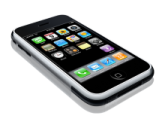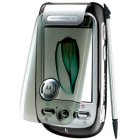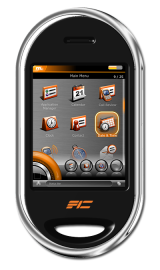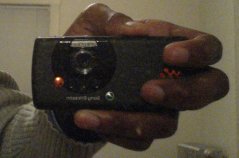The (Mobile) Devil You Know 16 years, 5 months ago by Martey Dodoo
Some of you may have wondered which cell phone I planned to replace my Cingular 8525 with. Since it is clear that I hate Windows Mobile, my smartphone choices are limited. Here are some phones I considered that run other mobile operating systems:
Apple iPhone
First things first. I do not hate Apple. If the MacBook's or MacBook Pro's prices ever came in line with their specifications (right now, it seems like buyers are paying a couple of hundred dollars for the privilege of running Mac OS X), I might buy one as my personal computer.
That said, it was pretty clear from the beginning that I was not going to buy the iPhone. Since you need iTunes to activate it, you need either Windows or OS X in order to use and synchronize it. I have already tried changing my operating system in order to get complete support for my cell phone, and it has not worked out.[1] As I have not found any documentation online about how to synchronize a Linux machine with it, I am fairly certain that the process would be even more difficult than working with my 8525.
The iPhone has an amazing user interface. The 8525 has UMTS and HSDPA and a QWERTY keyboard. Still, the iPhone and the 8525 cost the same, and neither of them fulfill my requirements in a smartphone.

Motorola MING (A1200)
The MING, as its name suggests, was originally intended for Chinese markets. It is a touchscreen phone. It seems to have decent reviews and only costs about $300 unlocked.
Unfortunately, I hate Motorola phones. Why? Because contacts can only have one phone number. While this is understandable in SIM cards where memory is limited and the focus is on storing phone numbers, this does not make any sense in a phone with a large amount of memory - especially it claims to be a smartphone - which should, at the very least, have decent contact management features. It is only on Motorola phones where I have run into this limitation. If I want to see the last time I talked to you, I do not really care whether I called your cell phone, the phone in your office, or your landline at home - I just need to know when we last talked. Motorola's ridiculous design decision (how many people do you know who only have one phone number?) makes this impossible.
The main reason I considered this phone (despite the contacts issue) is because it runs Motorola's version of Linux (known as EZX or MotoLinux). Unfortunately, this and other MotoLinux phones are not open,[2] which restricts a large number of potentially cool things that could be done with them (including fixing my issues with Motorola's concept of an address book).
OpenMoko Neo1973

Now, I really want to like the Neo1973. This is not because it runs Linux, but because its goal is to be an truly open smartphone. When I was staying up nights trying to get my 8525 to synchronize with my laptop running Ubuntu, I constantly thought to myself, "If I had a Neo 1973, this would be easy." Unlike the three previous phones discussed, it would be relatively easy for me to create an ad-hoc synchronization framework by writing two applications - one to run on a computer, and one to run on the Neo 1973. Of course, in a best case scenario, I would not have to write code in order to get the phone to work seamlessly.
Therein lies the rub. The software for the Neo 1973 is woefully incomplete. Since it is in a constant state of development, many of the built-in applications are incomplete, and gsmd does not always work (which makes it difficult to send or receive calls).
While using unstable software does not really bother me all that much (the gsmd instability is disconcerting, but I think everything else would be surmountable), OpenMoko Bug #666 does. Certain SIM cards with 3G capability do not work in the Neo1973, especially those from AT&T. A page on the OpenMoko wiki describing the situation has a table with SIM card SKUs. It does not look good for my SIM card, which would mean that I would have to wait for a firmware update for the GSM modem.
In addition to the possibility of not being able to use the device as a cell phone because the software does not work and the likelihood that my SIM card will not work properly, I have issues with the hardware specifications. The current developer-only revision of the phone only has the ridiculously slow GPRS for cellular data access. A version that might be on sale to developers in Decembers (it was originally supposed to be sold to the public starting this month) includes WiFi, but still does not have a faster cellular radio or a camera. The openness is nice, but the lack of innovative hardware and working software are not.
Meet My New Phone - Same as the Old Phone
In the end, I ended up getting another Sony Ericsson w810i, which I previously purchased for myself last January.[3] This time around, I tried to save $100 by buying a Cingular-branded phone on eBay instead of buying an unlocked version from SE. I am regretting that particular decision because the Cingular firmware's maximum volume is too low (especially when walking along the incredibly noisy Massachusetts Avenue), the menu are cluttered with links to AT&T Wireless' online stores, and it is impossible to use MP3s as ringtones (because you are supposed to pay for them twice).
Despite these and other flaws, the w810i generally works well enough that I am happy with it. While it does have EDGE, I have disabled all data access and canceled my unlimited plan. It is all about returning to a simpler time - a time where a cell phone was just a cell phone, camera, and MP3 player.
Further Reading
- A Wired News article on open cell phones, with pictures. It would have been more interesting if most of the phones they mentioned were not either vaporware or not actually cell phones.
--
[1] If I was one of those poor deluded Windows users who was convinced that Mac OS X would be a silver bullet for all of my technology issues, then my cost-benefit analysis might be different.
[2] OpenEZX explains the situation on their About page:
However, Motorola have "locked down" the phone. They don't want their users to make use of Linux, but rather only use the J2ME API's for their own applications. They don't publish any SDK for development of native Linux applications :(But who wants to develop bloated Java code, if the phone is a full-fledged Linux device?
[3] I would still have this phone, but someone in my family decided to drop their phone into a bowl of cereal. This is why I don't eat breakfast.
